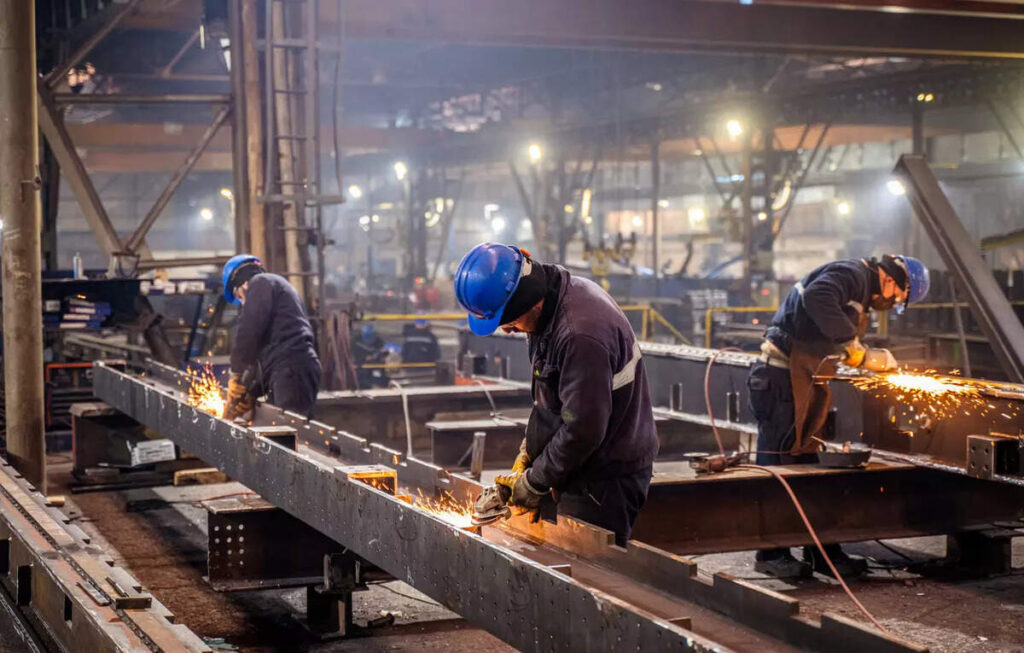NEW DELHI: Growth in industrial production slowed to a six-month low at 2.9 per cent in February this year as a high base and lacklustre demand pulled it down.
In February 2024, the index of industrial production (IIP) grew 5.6 per cent aided by the leap year, while in January this year it grew at 5.2 per cent.
Data released by the statistics ministry showed slowdown in output growth in mining (1.6 per cent) and manufacturing (2.9 per cent), while electricity generation (3.6 per cent) grew at a relatively quicker pace in February this year.
As per use-base classification, capital goods (8.3 per cent) and infrastructure goods (6.6 per cent) grew at a robust rate, while growth in primary goods (2.8 per cent) and intermediate goods (1.5 per cent) decelerated. Output of consumer durable goods rose by 3.8 per cent in February, while growth in output of consumer non-durables (-2.1 per cent) continued to stay in the negative territory for the third month in a row.
Rajani Sinha, chief economist at Care Ratings, said the moderation in mining and manufacturing output more than offset the improvement in electricity output, weighing on the overall growth number in February. “While public capex is likely to remain supportive, private sector investment is expected to be tepid in the coming quarters on account of global uncertainties,” she added.
Aditi Nayar, chief economist at Icra, said performance of most of the available high-frequency indicators — including electricity generation and mobility & transport-related ones such as GST e-way bill generation, port cargo traffic, diesel and petrol consumption, and vehicle registrations — improved in March this year.
E-way bills, or electronic permits, generated by businesses for transporting goods within and across states, hit a record 124.5 million in March as businesses rushed to dispatch inventories before the end of the financial year.
“While the growth performance of mining is expected to deteriorate in March this year relative to the previous month, this is likely to be offset by an uptick in electricity generation, amid steady manufacturing growth. Icra expects the IIP growth to print at around 3 per cent in March, similar to the levels seen in February,” Nayar added.
While rural demand has been improving, the lagging urban demand continues to be a cause for concern, Sinha said. “Several factors such as robust agricultural production and expectations of a normal monsoon are likely to remain supportive of rural demand. Furthermore, the easing food inflation is a positive for the overall consumption recovery. However, the urban demand scenario must be monitored going forward,” she added.
Economists have been cautioning of a growth slowdown in the financial year 2025-26 (FY26) due to the ongoing tariff war. Moody’s Analytics on Thursday revised its India gross domestic product (GDP) forecast for calendar year 2025 downward by 30 basis points (bps) to 6.1 per cent due to tariff threats from the US possibly hitting gems & jewellery, medical devices, and textile industries the hardest.
Sinha said going ahead, global uncertainty continues to cast a shadow on both private investment and consumption. “However, the Reserve Bank of India’s (RBI’s) second rate cut and expected moderation in inflationary pressures will provide some support,” she added.
Source: Business Standard




 Army Officer Killed in Akhnoor Sector Amid Cross-Border Tensions
Army Officer Killed in Akhnoor Sector Amid Cross-Border Tensions 